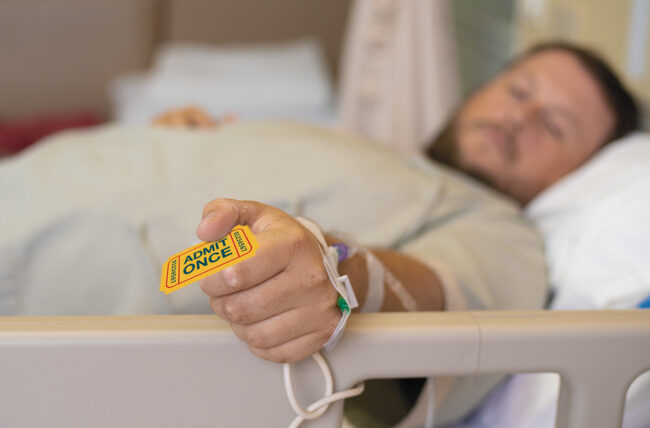How improving systemwide processes can decrease patient readmissions & improve quality
As the Centers for Medicare and Medicaid’s (CMS) value-based programs evolve and reimbursements are at stake, hospital systems are increasingly focused on driving down readmission rates using a comprehensive approach. Not only can preventing readmissions help health systems avoid penalties, it’s also a key factor in care quality and patient outcomes.
The priority of avoiding readmissions isn’t new for health systems, but as private payors follow CMS’ lead and threaten penalties, it’s taking on a higher level of urgency. “Medicare made hospital readmissions a quality metric,” says HealthTrust Physician Advisor

Ashley C. Mays, M.D., an otolaryngologist and surgeon, and the Director of Quality for Otolaryngology at Our Lady of the Lake Regional Medical Center.
These metrics can also impact a hospital’s reputation within the community—U.S. News & World Report rankings include quality metrics like readmission rates, Dr. Mays adds.
Recognizing the weak spots
Patients are readmitted for many reasons, and understanding those factors is key to addressing them. Dr. Mays categorizes readmissions in two ways: hospitalizations for surgical and medical care. Surgical readmissions occur when a patient experiences a setback directly related to a surgical procedure, such as a wound infection. Not all patients need postoperative inpatient rehabilitation or skilled nursing, so when surgical complications arise, hospital readmission may become necessary.
Medical readmissions occur when patients have a medical condition at home and do not fully recover. For example, a patient initially admitted for pneumonia or stroke may require readmission if the condition worsens or they’re unable to care for their condition at home.

Readmission is often due to a systemwide failure, where the transition of care was not well coordinated along the way, says Karen Bush, MSN, FNP, BC, NCRP, Director of Clinical Research & Education, Clinical Services, HealthTrust. “It’s not just a hospital issue or a patient issue. It’s about coordinating the care of patients within the hospital and ensuring they get safely captured by the appropriate resources upon discharge.”
The failure in the care coordination could mean that a patient doesn’t understand medication instructions or doesn’t have a primary care doctor to consult for how to handle complications. “Sometimes the patient has chronic conditions that are advanced, and it doesn’t take much to bring them back in,” Bush explains.
Using data to deepen understanding
Data can reveal readmission trends and inform actions that can be taken to reduce them. Dr. Mays developed an Enhanced Recovery After Surgery (ERAS) program for head and neck cancer patients using checklists, standardized processes and quality metrics, from the preoperative workup and inpatient surgery and hospital stay, to discharge and surgical outpatient follow-up. She and her team often review their own data to assess for program compliance and roadblocks to effective utilization.

Cindy Schultz, RN, MBA, Director of Population Health and Data Analytics at Beaumont Health, uses CMS claims data, including next-site-of-care data. These insights help Beaumont work with home health agencies and skilled nursing facilities on care issues.
For a heart failure readmissions program, Bush used to pull data from emergency department (ED) lists to understand whether her patients were readmitted within 30 days. A team including social workers, discharge planners, executive leaders and hospitalists then met to determine which factors may have contributed to these readmissions and to discuss future prevention measures.
Taking a continuous, systemwide approach
Not all readmissions are preventable, but to reduce the rate, providers must continue care when patients leave the hospital. Discharge planning should begin as soon as the patient is admitted. Social workers or case managers should assess the patient’s home situation, the patient’s and family’s comfort level dealing with the medical issues, and an understanding of all medications. “Waiting until the last minute to start these conversations is never a good idea,” says Dr. Mays.

Part of discharge planning can include a daily care manager round, where the patient’s situation is assessed with the nursing team. Providing the patient with daily updates about expected discharge dates and what will be needed at discharge helps the patient mentally prepare. Meanwhile, the staff should continue asking what the patient needs to ensure success at home, like home healthcare, rides to follow-up appointments, meals or medication payment assistance.
In addition, patients should be educated about their condition and medications while hospitalized, using a teach-back method, says Bush. After explaining how to take the medications or use a medical device like a blood glucose monitor, the patient explains it back to the provider to ensure understanding. Doing a medication reconciliation at every transition within the hospital and before discharge is vital, too. Go through the medication list with the patient and a pharmacist, if needed, to ensure the medications taken prior to and during hospitalization are reconciled and that the patient and family understand what to do at home.
The repetition of education throughout the hospitalization helps. When patients are being discharged, they often aren’t fully listening to discharge instructions and may not read them at home. “Getting the education earlier leads to greater success,” Bush says.
The transition to primary care outside the hospital is important, too, especially if the patient is high risk. The hospitalist should ensure the hospital care summary is in the primary care physician’s office within 24 to 48 hours, so they will be prepared if the patient calls, says Bush. Patients should be told at discharge when to call their primary care doctor if they have symptoms or issues, to help avoid going to the ED for something that could have been addressed sooner. Readmissions are sometimes minimized by discharging a patient to a rehabilitation or skilled nursing facility for post-acute care.
Tools to prevent readmission
Beaumont Health uses a variety of follow-up programs. All discharged patients receive a robocall the day after a hospital stay, asking them a series of questions, such as whether they understood their discharge instructions. If the patient answers no, this creates a trigger for a team member to call them.
About 40% of patients respond to this robocall, triggering about 300 follow-ups weekly, often to discuss medication issues.
Additional follow-up intervals depend on the payor and population.

“When we look at the populations served by the program, we see lower readmission rates for those we outreach to than those we don’t,” says Paula Levesque, RN, Associate Chief Nursing Officer at Beaumont Health. They work with third-party organizations for some follow-up efforts and chart the outreach efforts. Beaumont is involving stakeholders and setting up pilots based on the needs identified from follow-up calls and outreach efforts.
The addition of reimbursement for telehealth due to the pandemic has also been instrumental. “Telehealth is a huge tool for reducing readmissions,” Bush adds. “It makes care accessible in the home.”
There is no one solution, though, and reducing readmissions on a population level is challenging. “It’s hard to identify a magical intervention that will make a huge difference,” explains Schultz. But breaking down care siloes between healthcare organizations to follow up on care after discharge and partnering with post-acute providers are having a positive impact.
The best byproduct of working toward reducing readmissions is in the eyes of patients. “Within our group, we’ve seen improvement in overall quality,” Dr. Mays says. “Regardless of whether objective data improved, the subjective experience improved. Patients are feeling like care is more organized and standardized, and they feel people are taking more time and effort to educate them.”
For more tips on best discharge practices, visit the Agency for Healthcare Research and Quality’s Re-Engineered Discharge (RED) Toolkit.
Share Email CMS, Patient Outcomes, Q2 2022




